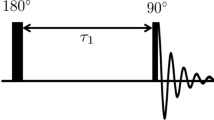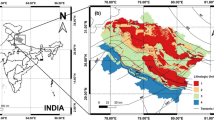Abstract
Rock physics has proven its credibility for the quantitative seismic interpretation of reservoir and reservoir characterization. In this study, we implemented K-means clustering to group data points more objectively and without prior misconceptions into clusters. Furthermore, we used the grouping suggested by the algorithm for our study. We integrated rock physics and K-means cluster analysis to determine a possible hydrocarbon reservoir using three well logs data. Initially, K-means clustering was implemented on density logs and based on the arithmetic mean of each density log cluster, sandstone and shale-dominant parts were identified and separated. Then, rock physics parameters were computed for the sandstone-dominant part of the well logs. Based on the cross-plots of Lame’s constants with density product, and Lame’s constants ratio, additional lithology discrimination was done for the identification of a clean gas-sand zone. In the clean gas-sand zone, two different pore fluids zones were identified based on Vp/Vs ratio, Poisson ratio, P- and S-wave impedances. Finally, statistical analysis was carried out to observe the underlying frequency distribution of rock physics parameters. The integration of cluster analysis and rock physics gave us significant information about the presence of different fluids and the existence of a potential hydrocarbon reservoir.













Similar content being viewed by others
References
Al-Mudhafar, W. J., Al Lawe, E. M., & Noshi, C. I. (2019). Clustering analysis for improved characterization of carbonate reservoirs in a Southern Iraqi Oil Field. Paper presented at the offshore technology conference.
Al-Mudhafar, W., & Bondarenko, M. (2015). Integrating K-means clustering analysis and generalized additive model for efficient reservoir characterization. Paper presented at the 77th EAGE conference and exhibition 2015.
Bação, F., Lobo, V., & Painho, M. (2005). The self-organizing map, the Geo-SOM, and relevant variants for geosciences. Computers & Geosciences, 31(2), 155–163.
Bateman, R. M. (1977). The fluid identification plot. Paper presented at the SPWLA 18th annual logging symposium, Houston, Texas.
Brown, G., Rees, H., Toro, M., & Arceneaux, C. L., Jr. (1995). Using production-log data from horizontal wells. Paper presented at the SPWLA 36th annual logging symposium, Paris, France.
Castagna, J. P., Batzle, M. L., & Eastwood, R. L. (1985). Relationships between compressional-wave and shear-wave velocities in clastic silicate rocks. Geophysics, 50(4), 571–581.
Chen, S., Di Rosa, D. E., Gyllensten, A., Georgi, D., & Tauk, R. S. (2006). Use of the NMR diffusivity log to identify and quantify oil and water in carbonate formations. Paper presented at the Abu Dhabi international petroleum exhibition and conference, Abu Dhabi, UAE. https://doi.org/10.2118/101396-MS.
Chombart, L. G. (1960). Well logs in carbonate reservoirs. Geophysics, 25(4), 779–853.
Dco, P. P., Rao, R. V., & Singh, B. (1998). Identification of gas-oil contacts by overlay techniques using wireline log data. The Log Analyst, 39(03), 25.
Deng, M., Liu, Q., Cheng, T., & Shi, Y. (2011). An adaptive spatial clustering algorithm based on Delaunay triangulation. Computers, Environment and Urban Systems, 35(4), 320–332.
Duda, R. O., Hart, P. E., & Stork, D. G. (1973). Pattern classification and scene analysis (Vol. 3). New York: Wiley.
Euzen, T., Delamaide, E., Feuchtwanger, T., & Kingsmith, K. D. (2010). Well log cluster analysis: An innovative tool for unconventional exploration. Paper presented at the Canadian unconventional resources and international petroleum conference.
Fayyad, U. M., Piatetsky-Shapiro, G., Smyth, P., & Uthurusamy, R. (1996). Advances in knowledge discovery and data mining (Vol. 21). Menlo Park: AAAI Press.
Fukunaga, K. (2013). Introduction to statistical pattern recognition. Amsterdam: Elsevier.
Gersho, A., & Gray, R. M. (2012). Vector quantization and signal compression (Vol. 159). New York: Springer.
Goodway, B., Chen, T., & Downton, J. (1997). Improved AVO fluid detection and lithology discrimination using Lamé petrophysical parameters;“λρ”, “μρ”, & “λ/μ fluid stack”, from P and S inversions. SEG technical program expanded abstracts 1997 (pp. 183–186). Society of Exploration Geophysicists.
Guha, S., Rastogi, R., & Shim, K. (1998). CURE: An efficient clustering algorithm for large databases. ACM Sigmoid Record, 27(2), 73–84.
Hartigan, J. A. (1975). Clustering algorithms. New York, NY: Wiley.
Heslop, A., & Pickel, J. S. (1978). Fluid contact monitoring in some western Canadian Reefs. The Log Analyst, 19(02), 8.
Karypis, G., Han, E.-H., & Kumar, V. (1999). Chameleon: Hierarchical clustering using dynamic modeling. Computer, 32(8), 68–75.
McCreery, E., & Al-Mudhafar, W. (2017). Geostatistical classification of lithology using partitioning algorithms on well log data—A case study in forest hill oil field, East Texas Basin. Paper presented at the 79th EAGE conference and exhibition 2017.
McCreery, E. B., & Al-Mudhafar, W. J. (2017). Geostatistical classification of lithology using partitioning algorithms on well log data—A case study in forest hill oil field, East Texas Basin. 2017(1), 1–5.
Miller, H. J., & Han, J. (2009). Geographic data mining and knowledge discovery. Boca Raton: CRC Press.
Nazeer, K. A., & Sebastian, M. (2009). Improving the accuracy and efficiency of the k-means clustering algorithm. Paper presented at the proceedings of the world congress on engineering.
Omudu, L. M., Ebeniro, J. O., Xynogalas, M., Olotu, S., & Osayande, N. (2008). Fluid discrimination and reservoir characterization from onshore Niger Delta. Paper presented at the 2008 SEG annual meeting, Las Vegas, Nevada.
Pickett, G. R. (1963). Acoustic character logs and their applications in formation evaluation. Journal of Petroleum Technology, 15(06), 659–667.
Puskarczyk, E. (2020). Application of multivariate statistical methods and artificial neural network for Facies analysis from well logs data: An example of Miocene deposits. Energies, 13(7), 1548.
Queen, M. (1966). Some methods for classification and analysis of multivariate observations (Methods for classification and analysis of multivariate observations).
Tzanis, G., Katakis, I., Partalas, I., & Vlahavas, I. (2006). Modern applications of machine learning. Paper presented at the proceedings of the 1st annual SEERC doctoral student conference–DSC.
Veeken, P., & Van Moerkerken, B. (2007). Seismic stratigraphic techniques. Handbook of geophysical exploration: Seismic exploration (pp. 111–234).
Wagstaff, K. (2012). Machine learning that matters. arXiv preprint arXiv:1206.4656.
Wang, Q., Wang, C., Feng, Z.-Y., & Ye, J.-F. (2012). Review of K-means clustering algorithm. Electronic Design Engineering, 20(7), 21–24.
Wu, X., & Nyland, E. (1986). Well log data interpretation using artificial intelligence technique. Paper presented at the SPWLA 27th Annual Logging Symposium, Houston, Texas.
Xu, R., & Wunsch, D. (2008). Clustering (Vol. 10). New York: Wiley.
Zhang, T., Ramakrishnan, R., & Livny, M. (1996). BIRCH: An efficient data clustering method for very large databases. ACM Sigmoid Record, 25(2), 103–114.
Acknowledgment
The authors of this study are grateful to the School of earth sciences, Zhejiang University, Hangzhou, China, for providing an excellent working environment and research facilities.
Author information
Authors and Affiliations
Corresponding author
Rights and permissions
About this article
Cite this article
Ali, A., Sheng-Chang, C. & Shah, M. Integration of Cluster Analysis and Rock Physics for the Identification of Potential Hydrocarbon Reservoir. Nat Resour Res 30, 1395–1409 (2021). https://doi.org/10.1007/s11053-020-09800-6
Received:
Accepted:
Published:
Issue Date:
DOI: https://doi.org/10.1007/s11053-020-09800-6




